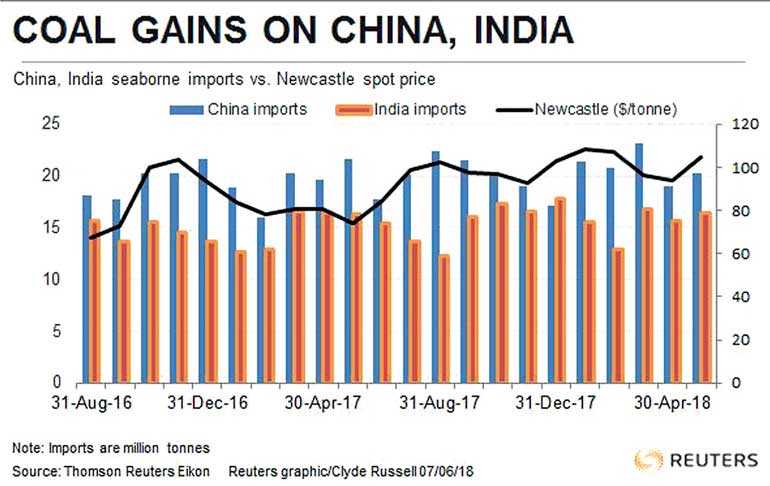Monday Jan 05, 2026
Monday Jan 05, 2026
Monday, 18 June 2018 00:00 - - {{hitsCtrl.values.hits}}
LAUNCESTON, Australia (Reuters): Coal prices in Asia are being driven to multi-year highs by a rare combination of simultaneous demand growth in the region’s top four importers.
Depending on the price used, thermal coal is either close to a two-year high or near the strongest in six years as China, India, Japan and South Korea imported more of the polluting fuel in the first five months of this year compared to the same period in 2017.
The Australian thermal coal benchmark, the weekly Newcastle Index, ended last week at $108.89 a ton, not far from the $110.60 hit in late February, which was the highest price since March 2012.
The daily spot price for Newcastle cargoes hit $114.50 a ton on Monday (4 June), the highest since reaching $114.75 in November 2016, which in turn was the best since March 2012.
Lower grade thermal coal from Indonesia has also been performing strongly, with 4,200 kilocalorie per kilogram coal assessed by Argus Media ending last week at $46.82 a ton, up 14% since the year low in mid-April.
It’s still below the peak this year of $51.04 a ton from late February, which was the highest price since October 2011.
No matter which way the numbers are sliced and diced, the message is the same, namely that coal prices are performing strongly despite the fuel becoming increasingly unpopular in many countries because of its contribution to air pollution and climate change.
It’s also unusual for the top four Asian importers to be demanding more seaborne coal at the same time, as is currently the case.
China imported 104.5 million tons of coal from the seaborne market in the first five months of the year, according to vessel-tracking and port data compiled by Thomson Reuters Supply Chain and Commodity Forecasts.
This was up 10.2%, or 10.7 million tons, from the same period in 2017, according to the data.
India, the second-biggest coal importer after China, brought in 77.4 million tons in the January-May period, up 3.3%, or 2.5 million tons, from the first five months of last year.
Third-ranked Japan imported 74.1 million tons, up 2.4 million tons, while the region’s number four importer, South Korea, brought in 51.7 million, a small gain of 500,000 tons.
Put together, these four countries imported 16.1 million tons more coal from the seaborne market in the first five months of the year.
US, Russia winners
This has had the effect of tightening the market, given the lack of new supplies to meet the demand.
In fact, exports from the top three shippers to Asia have been remarkably flat in the January-May period, according to the vessel-tracking data. Australia shipped 161.8 million tons in the first five months, up slightly from the 160.6 million in the same period in 2017.
Indonesia managed 167.7 million tons, up from 161.2 million, while South Africa was steady at 33.6 million.
This means that the increase in import demand isn’t really being met by the traditional export powerhouses, allowing countries such as the United States and Russia to plug the gap.
The United States shipped 41.7 million tons of coal in the first five months of 2018, with 14.7 million tons heading to Asia.
This is up 14.9% from the 36.3 million tons it shipped in the same period in 2017, of which 12.1 million went to Asia.
It’s a similar story for Russia, with total shipments up 9.8%, or 7.1 million tons, to 79.8 million tons, of which 33.2 million tons went to Asia, a gain of 11.8%.
What the numbers show is that even though prices are high, and rising, the traditional major exporters are struggling to boost shipments.In Australia this is most likely because of an inability to boost production quickly enough, in Indonesia it’s largely because the government is mandating that more coal be supplied to the domestic market, and in South Africa there are infrastructure constraints, mainly on the rail system.
The numbers also show that currently the price of coal is high enough to make US cargoes competitive in Asia, despite the greater cost of freight.
The bulk of US coal exported to Asia is coking coal used to make steel, but with the thermal price above $100 a ton, it’s likely that more of the power-station fuel will head east, especially to buyers in South Asia.
